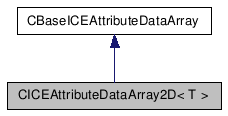Detailed Description
template<class T>
class XSI::CICEAttributeDataArray2D< T >
This template class encapsulates ICEAttribute data as a 2D array. CICEAttributeDataArray2D objects are read-only and can be filled with the methods supplied with the ICEAttribute class. CICEAttributeDataArray2D is zero-based and can be one of the following types:
- CICEAttributeDataArray2DFloat
- CICEAttributeDataArray2DLong
- CICEAttributeDataArray2DBool
- CICEAttributeDataArray2DVector2f
- CICEAttributeDataArray2DVector3f
- CICEAttributeDataArray2DVector4f
- CICEAttributeDataArray2DQuaternionf
- CICEAttributeDataArray2DRotationf
- CICEAttributeDataArray2DMatrix3f
- CICEAttributeDataArray2DMatrix4f
- CICEAttributeDataArray2DColor4f
- CICEAttributeDataArray2DShape
All types are associated to specific ICEAttribute 2D types. Therefore, you need to declare the right array object type that matches the ICEAttribute data type you want to access. Otherwise a runtime error will occur and the returned array will be empty.
- See also:
- ICEAttribute::GetDataArray2D, ICEAttribute::GetDataArray2DChunk, Type Definitions for CICEAttributeDataArray2D
- Since:
- 7.0
- Example:
- This example demonstrates how to iterate over the
EnvelopeWeightsPerDeformer ClusterProperty attribute
data on en envelope.
using namespace XSI; X3DObject cone = CreatePrim( L"Cone", L"MeshSurface", L"", L""); Create2DSkeleton( 2.95, 3.34, -0.33, 4.73, 0.0, 0.0, -5.71, 0, 0, 4, CValue(""), CValue("")); AppendBone( L"eff", 3.70, -3.02, 0.30, L""); XSI::siConstructionMode mode = siConstructionModeModeling; ApplyFlexEnv( L"cone;bone,bone1,eff", true, mode ); SelectObj( L"cone.polymsh.cls.EnvelopWeightCls.Envelope_Weights", L"", L"" ); // Make sure to generate the data first cone.GetActivePrimitive().GetGeometry(0); Application xsi; ProjectItem envProp = xsi.GetSelection()[0]; ICEAttribute attr = envProp.GetICEAttributeFromName( L"EnvelopeWeightsPerDeformer" ); CICEAttributeDataArray2DFloat weight2D; attr.GetDataArray2D( weight2D ); for( ULONG i=0; i<weight2D.GetCount( ); i++ ) { CICEAttributeDataArray< float > weights; weight2D.GetSubArray( i, weights ); for( ULONG j=0; j<weights.GetCount( ); j++ ) { xsi.LogMessage( CString( weights[ j ] ) ); } } // Helpers CValue CreatePrim( const CString& in_presetobj, const CString& in_geometrytype, const CString& in_name, const CString& in_parent ) { CValueArray args(4); CValue retval; args[0]= in_presetobj; args[1]= in_geometrytype; args[2]= in_name; args[3]= in_parent; Application app; app.ExecuteCommand( L"CreatePrim", args, retval ); return retval; } CValue Create2DSkeleton( const CValue& in_rx, const CValue& in_ry, const CValue& in_rz, const CValue& in_ex, const CValue& in_ey, const CValue& in_ez, const CValue& in_nx, const CValue& in_ny, const CValue& in_nz, const CValue& in_viewtype, CValue& out_bone, CValue& out_effector ) { CValueArray args(12); CValue retval; args[0]= in_rx; args[1]= in_ry; args[2]= in_rz; args[3]= in_ex; args[4]= in_ey; args[5]= in_ez; args[6]= in_nx; args[7]= in_ny; args[8]= in_nz; args[9]= in_viewtype; Application app; app.ExecuteCommand( L"Create2DSkeleton", args, retval ); out_bone = args[10]; out_effector = args[11]; return retval; } CValue AppendBone( const CValue& in_inputobjs, const CValue& in_ex, const CValue& in_ey, const CValue& in_ez, bool in_pin ) { CValueArray args(5); CValue retval; args[0]= in_inputobjs; args[1]= in_ex; args[2]= in_ey; args[3]= in_ez; args[4]= in_pin; Application app; app.ExecuteCommand( L"AppendBone", args, retval ); return retval; } CValue ApplyFlexEnv( const CValue& in_connectionset, bool in_assignnewdeformers, XSI::siConstructionMode & io_constructionmode ) { CValueArray args(3); CValue retval; args[0]= in_connectionset; args[1]= in_assignnewdeformers; args[2]= io_constructionmode; Application app; app.ExecuteCommand( L"ApplyFlexEnv", args, retval ); io_constructionmode = (XSI::siConstructionMode)(LONG)args[2]; return retval; } void SelectObj( const CValue& in_selectionlist, const CString& in_hierarchylevel, bool in_checkobjectselectability ) { CValueArray args(3); CValue retval; args[0]= in_selectionlist; args[1]= in_hierarchylevel; args[2]= in_checkobjectselectability; Application app; CStatus st = app.ExecuteCommand( L"SelectObj", args, retval ); return; }
#include <xsi_iceattributedataarray2D.h>
Inheritance diagram for
CICEAttributeDataArray2D< T >:

Public Member Functions |
|
| CICEAttributeDataArray2D () | |
| ~CICEAttributeDataArray2D () | |
| CStatus | GetSubArray (ULONG in_index, CICEAttributeDataArray< T > &out_dataArray) const |
Constructor & Destructor Documentation
| CICEAttributeDataArray2D | ( | ) | [inline] |
Constructor.
| ~CICEAttributeDataArray2D | ( | ) | [inline] |
Destructor.
Member Function Documentation
| CStatus GetSubArray | ( | ULONG | in_index, |
| CICEAttributeDataArray< T > & | out_dataArray | ||
| ) | const [inline] |
Accessor to the encapsulated array. This operator is called when reading the data so the return value is read-only.
- Parameters:
-
in_index Index in the array. The index must be smaller than the number of elements in the array, otherwise the results are unpredictable. out_dataArray A read-only reference to a CICEAttributeDataArray<T>object at a specific index.
- Returns:
- CStatus::OK Success
-
CStatus::InvalidArgument If
in_indexorout_dataArrayis invalid.
The documentation for this class was generated from the following file:
